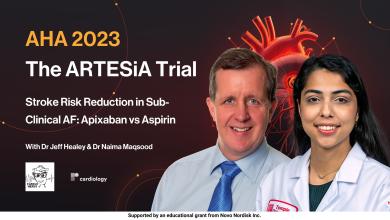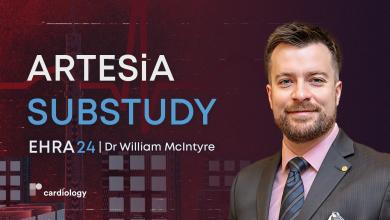Search results
Author(s):
Naima Maqsood
,
Jeff Healey
Added:
5 months ago
AHA 2023 — Dr Naima Maqsood, CardioNerds ambassador (Temple University Hospital, US) interviews investigator, Dr Jeff Healey (McMaster University, CA) to outline the findings from a phase 4 trial of apixaban to reduce thromboembolism in patients with subclinical atrial fibrillation (AF).ARTESiA (NCT01938248) aims to determine if apixaban in combination with aspirin can reduce the instance of…
View more
Author(s):
Matthew Reynolds
Added:
6 years ago
Matthew Reynolds from Lahey Hospital & Medical Center, Burlington, Massachusetts, USA discusses AEIOU: Apixaban Evaluation of Interrupted or Uninterrupted Anticoagulation for Ablation of Atrial Fibrillation.
Filmed by Radcliffe Cardiology on-site at HRS 2017.
View more
Author(s):
William McIntyre
Added:
1 week ago
EHRA 24 - Investigator, Dr William McIntyre (Population Health Research Institute, CA) joins us to discuss the findings from a substudy of ARTESiA (NCT01938248).ARTESiA was a randomized, parallel assignment clinical trial which aimed to assess if apixaban could reduce the risk of ischemic stroke and systemic embolism in patients with subclinical atrial fibrillation (AF) and additional risk…
View more
Author(s):
Manesh R Patel
Added:
2 years ago
In this short interview from our coverage of ACC.22 late-breaking trials, Dr Manesh Patel (Duke Heart Center, US) discusses the multicentre, randomised, double-blind PACIFIC-AF trial (Bayer)(NCT04218266).
The trial sought to determine the efficacy of the oral FXIa inhibitor asundexian and evaluate the safety of the drug, compared to the non-vitamin K oral anticoagulant (NOAC) apixaban, in…
View more
Author(s):
Demosthenes G Katritsis
,
Bernard J Gersh
,
A John Camm
Added:
3 years ago
Thrombotic material in atrial fibrillation(AF) usually develops in the left atrial appendage as a result of decreased flow and stasis, possible endothelial dysfunction and a hypercoagulable state as indicated by increased fibrinogen, D-dimer, thromboglobulin and platelet factor 4 levels.1 In the Framingham Heart Study, the percentage of strokes attributable to AF increases steeply from 1.5 % in…
View more
Author(s):
Pascal Vranckx
,
Marco Valgimigli
,
Hein Heidbuchel
Added:
3 years ago
Anticoagulation with vitamin K antagonists (VKAs) has been used for the long-term treatment and prevention of thromboembolic diseases and for stroke prevention in atrial fibrillation (AF) for the past half century. Until the last decade, VKAs were the only oral anticoagulant (OAC) agents available, and warfarin remains the most commonly prescribed OAC worldwide.1 Direct oral anticoagulants (DOACs…
View more
Author(s):
Philipp Bushoven
,
Sven Linzbach
,
Mate Vamos
,
et al
Added:
3 years ago
Atrial Fibrillation, Cardioversion and Stroke Risk
Atrial fibrillation (AF) is the most common serious chronic heart rhythm disorder with an estimated prevalence in the general population of around 1%.1 The arrhythmia affects about 2.2 million persons in the US and 4.5 million individuals in the EU. Due to the advancing age of the population, the prevalence of AF is likely to increase even…
View more
Author(s):
Nur A Rahmat
,
Gregory YH Lip
Added:
3 years ago
Until recently, the vitamin K antagonist (VKA, e.g. warfarin) class of drugs was the only oral anticoagulant in use. VKAs have important inter- and intra-patient variability, influenced by diet, alcohol and drugs; thus, regular anticoagulation monitoring is necessary. Indeed, VKAs offer their best efficacy and safety when the average time in therapeutic range (TTR) is >65–70 % in a particular…
View more
Author(s):
Yousif Ahmad
,
Gregory YH Lip
Added:
3 years ago
Atrial fibrillation (AF) leads to a prothrombotic state1 and places patients at risk of thromboembolic disease. The most common and serious complication of thromboembolism is stroke, and AF is held responsible for 25 % of all strokes.2 Strokes in the context of AF are associated with a higher mortality, longer hospital stay and lower levels of independence at discharge.3 These factors combine to…
View more
Author(s):
Marco Alings
Added:
3 years ago
Atrial Fibrillation(AF) is the most common cardiac arrhythmia, with the highest prevalence in elderly patients, and is characterised by an irregular heart rhythm that may result in clots in the heart that can spread throughout the circulatory system. It is seen in approximately 2 % of the European adult population and is a significant cause of increasing healthcare costs in developed countries.1…
View more

















